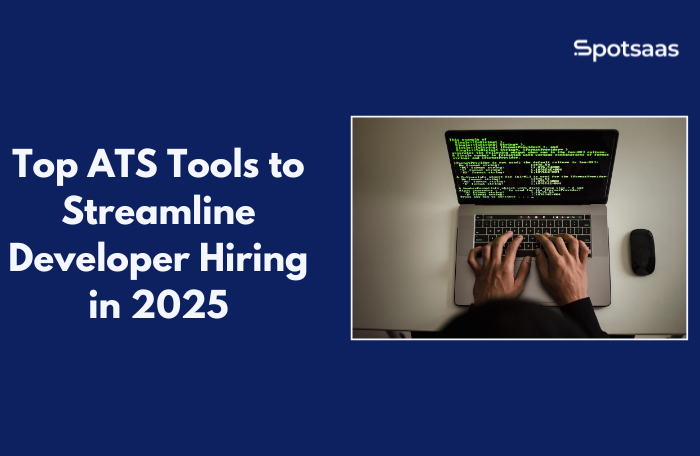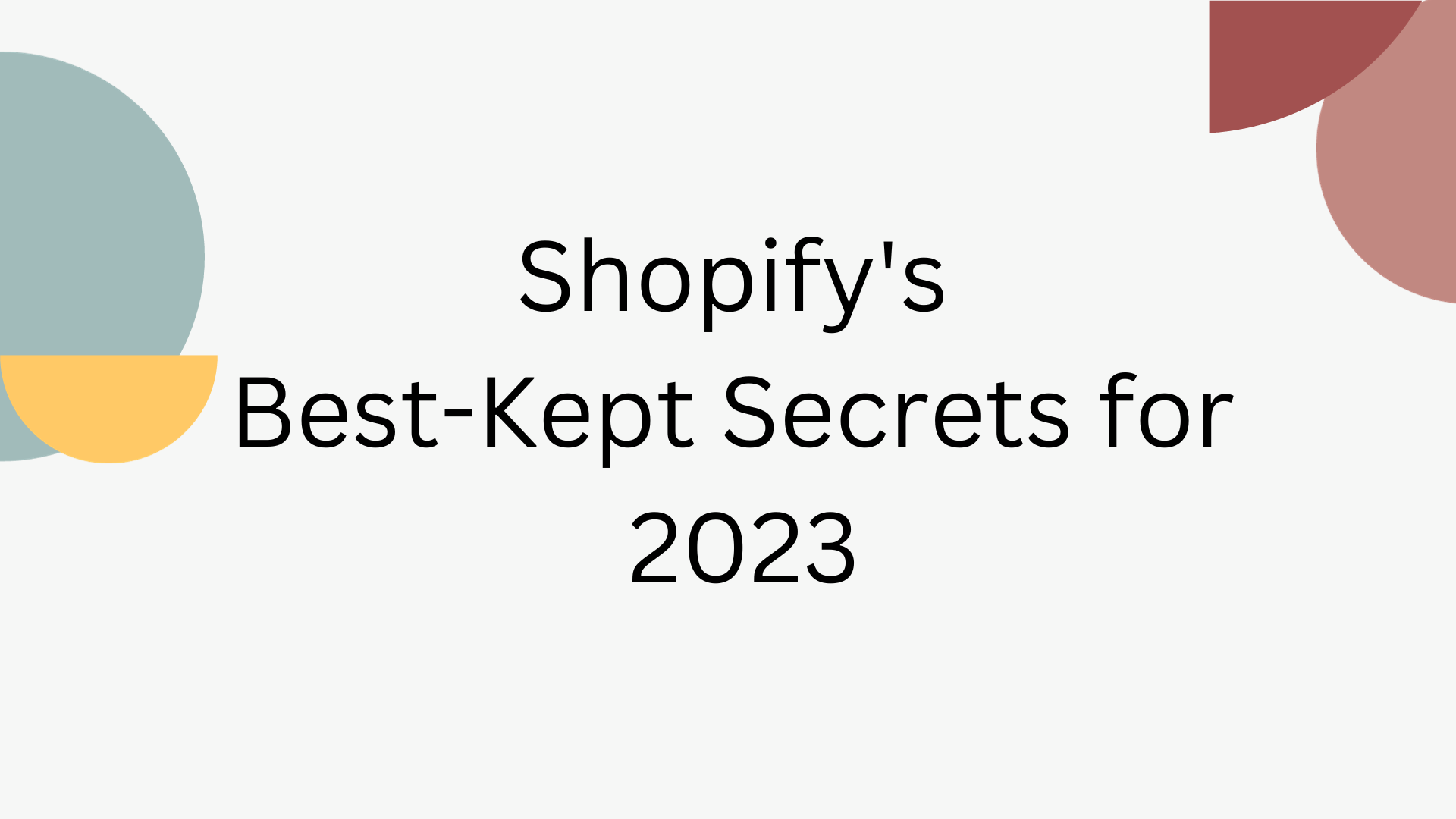Finding the right developers can feel like a moving target, especially when resumes, coding tests, and interviews pile up across different tools. That’s where an Applicant Tracking System (ATS) can make a real difference. Whether you’re hiring your first engineer or scaling a full-stack team, an ATS built for developer hiring helps streamline sourcing, screening, and collaboration.
This blog breaks down how these tools work, which features matter most, and which platforms stand out in 2025, so you can spend less time managing tasks and more time making great hires.
What This Blog Includes
If you’re evaluating software to help you hire developers more effectively, this blog offers a practical guide to support your decision-making process. Here’s what you’ll find:
- How ATS tools support developer hiring: A quick overview of how modern tracking systems simplify sourcing, screening, and team collaboration.
- Key features that matter: A breakdown of the most relevant capabilities to look for when hiring tech talent, like coding test integrations and sourcing from platforms developers actually use.
- Top-rated ATS platforms in 2025: A curated list of trusted tools built to handle technical hiring needs across different company sizes.
- Side-by-side comparison: A visual summary to help you weigh pricing, functionality, and suitability at a glance.
- Setup guidance and common questions: Actionable tips to help you get started, plus answers to questions recruiters and hiring managers often ask when choosing a tool.
Each section is built to save you time and help you choose a solution that aligns with your hiring goals.
Why Hiring Developers Needs Specialized ATS Tools
Hiring developers comes with its own set of expectations, and general-purpose applicant tracking systems often fall short. Here’s why a specialized ATS can make all the difference:
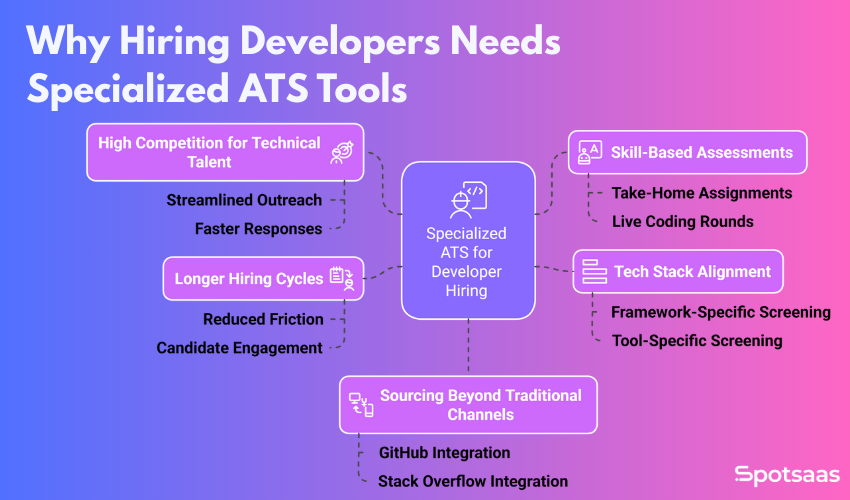
High Competition for Technical Talent
Skilled developers are in high demand and often receive multiple offers. A delay in sourcing or responding can result in losing top candidates. A specialized ATS helps you move faster by streamlining outreach and follow-ups.
Skill-Based Assessments Are a Must
Technical roles require more than a strong resume. Many hiring processes include take-home assignments, live coding rounds, or integrated assessments. An ATS that supports or connects with coding test platforms simplifies this stage.
Tech Stack Alignment Matters
Hiring for a React developer is different from hiring someone with Python or AWS experience. A developer-focused ATS allows for filtering and screening based on specific frameworks, tools, and languages, making your shortlists more accurate.
Longer Hiring Cycles and Drop-Off Risks
Developer hiring can take more time due to technical interviews and team involvement. The right ATS helps reduce friction with built-in scheduling tools, reminders, and collaborative feedback, keeping candidates engaged throughout the process.
Sourcing Beyond Traditional Channels
Developers often hang out on platforms like GitHub, Stack Overflow, and niche forums. A well-equipped ATS offers integrations or plugins that help you tap into these spaces directly, so you’re not limited to job boards alone.
Must-Have Features in Developer-Focused ATS
| Feature | Purpose |
|---|---|
| Code Assessment Integration | Enables you to evaluate technical skills through coding tests and real-world challenges. |
| Boolean Search & Resume Parsing | Helps you filter candidates faster based on languages, tools, or specific experience using smart keyword search. |
| Multi-channel Sourcing | Lets you find talent across job boards, social platforms, and developer-specific sites like GitHub and Stack Overflow. |
| Collaboration Tools | Enables recruiters and engineering teams to share feedback, score candidates, and move faster on decisions. |
| Automation | Handles repetitive tasks like interview scheduling, test invites, and email updates—so you can focus on hiring strategy. |
Best ATS Tools for Hiring Developers in 2025
Whether you’re hiring your first engineer or scaling a development team, the right ATS can simplify sourcing, screening, and collaboration. Below are five platforms that stand out in 2025 for tech-focused hiring needs:
Workable

Workable
- Spot Score 9.6
- Best For: Small to Mid-Sized Business
- Pricing: Starts from 169/month
Workable is a scalable hiring platform built for growing teams that need structure without complexity. It blends ease of use with powerful automation and sourcing tools, making it a reliable option for companies that want to move fast while keeping their hiring process organized and collaborative.
From AI-powered candidate suggestions to job board integrations and built-in video interviews, Workable helps hiring teams reach more candidates and streamline communication — all from one clean interface.
Key Features
| Feature | What It Helps With |
|---|---|
| AI Candidate Recommendations | Suggests top candidates automatically based on job requirements and past hiring patterns. |
| Job Board Distribution | Publishes listings across 200+ free and premium job boards with a single click. |
| Video Interview Tools | Allows asynchronous and live video interviews to speed up the screening process. |
| Custom Pipelines | Helps teams build and manage workflows that match their hiring process. |
| Team Collaboration | Enables feedback collection, role-based access, and shared notes across hiring teams. |
Why It Works for Recruitment Teams
Workable simplifies technical hiring without cutting corners. It brings the power of automation, AI matching, and centralized collaboration into one platform, helping recruiters source faster and reduce delays in feedback and scheduling.
Whether you’re hiring developers, product engineers, or technical leads, Workable keeps your team aligned, responsive, and efficient throughout every stage of the process.
Workable Pricing
Workable pricing is available in three core plans:
- Starter Plan: $149/month (up to 2 active jobs)
- Standard Plan: Custom pricing (based on job volume and features)
- Premier Plan: Custom pricing (includes advanced analytics and APIs)
Free Trial
Workable offers a 15-day free trial so hiring teams can explore its sourcing tools, interview scheduling, and pipeline customization before subscribing.
Pros & Cons
| Pros | Cons |
|---|---|
|
|
Ashby
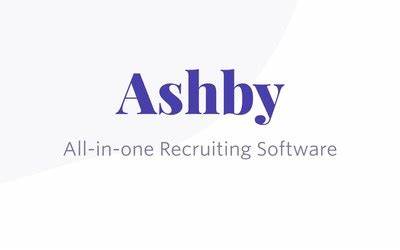
Ashby
- Spot Score – 8
- Best For: Startups and mid-sized tech companies
- Pricing: Starts from $360/month
Ashby is designed with fast-growing teams in mind. It brings together applicant tracking, analytics, scheduling, and structured hiring in one elegant system. What makes Ashby stand out is its ability to blend customization with automation, allowing hiring teams to build consistent processes without feeling boxed in.
From structured interview templates to detailed pipeline analytics, Ashby helps recruiters and hiring managers stay aligned while improving speed and decision-making at every stage.
Key Features
| Feature | What It Helps With |
|---|---|
| Structured Interview Plans | Ensures consistent and fair evaluation by defining questions and rubrics upfront. |
| Advanced Analytics & Reporting | Tracks pipeline health, time-to-hire, diversity metrics, and interviewer load with built-in dashboards. |
| Built-In Scheduling | Allows candidates to self-schedule interviews, reducing back-and-forth with recruiters. |
| Automation & Triggers | Eliminates repetitive tasks like follow-ups, reminders, and status changes. |
| Collaboration & Scorecards | Enables real-time feedback sharing, decision tracking, and structured scorecard reviews. |
Why It Works for Tech Hiring Teams
Ashby brings clarity to complex hiring. Its structured approach to interviews, combined with automation and analytics, makes it easier for teams to scale developer hiring without losing visibility or control. Recruiters can keep processes clean and repeatable, while hiring managers stay focused on quality—not logistics.
It’s especially useful for startups and tech companies that need to build hiring consistency early on, without sacrificing speed or candidate experience.
Pricing
Ashby pricing offers flexible pricing tailored to company size and hiring needs. Here’s a breakdown:
- Foundations Plan (1–10 employees): Starting at $300/month
- 11–25 employees: Approximately $400/month
- 26–50 employees: Approximately $500/month
- 51–75 employees: Approximately $700/month
- 76–100 employees: Approximately $900/month
For organizations with over 100 employees, Ashby provides custom pricing based on specific requirements and usage.
A 10% discount is available for annual commitments.
Free Trial
Ashby does not offer a public free trial, but teams can request a personalized demo to explore the platform before committing.
Pros & Cons
| Pros | Cons |
|---|---|
|
|
Greenhouse

Greenhouse is designed to help companies build a repeatable, data-backed hiring process. It brings structure to every stage of recruitment, making it easier to manage multiple openings, evaluate candidates fairly, and track team performance. What sets it apart is its focus on process consistency, collaboration, and measurable outcomes.
With hundreds of integrations and a modular setup, Greenhouse adapts to both growing companies and large enterprises looking to improve hiring efficiency across departments.
Key Features
| Feature | What It Helps With |
|---|---|
| Structured Hiring Flows | Creates a consistent interview process across all roles and departments. |
| Recruitment Analytics | Delivers insights on pipeline health, time-to-hire, and team activity. |
| Third-Party Integrations | Connects with HR, assessment, and onboarding tools to centralize your hiring stack. |
| Diversity Support Tools | Provides built-in features to help teams hire inclusively and remove bias. |
| Candidate Management CRM | Helps keep in touch with talent even before a role opens up. |
Why It Works for Recruiting Teams
Greenhouse stands out for companies that want structure without losing flexibility. The platform helps hiring managers follow a clear process while giving recruiters the tools they need to move quickly, collaborate easily, and track progress in real time. Whether it’s high-volume hiring or niche roles, teams benefit from consistent workflows and built-in accountability.
Pricing
Greenhouse pricing offers tiered pricing plans that scale with your hiring volume and feature needs:
- Essential Plan: Includes core ATS functionality for growing teams
- Advanced Plan: Adds deeper reporting, automation, and more integrations
- Expert Plan: Ideal for large teams with security, compliance, and onboarding needs
Final pricing is customized based on company size and selected tools.
Free Trial
Greenhouse does not offer a free trial. However, companies can request a demo to understand features and evaluate how the platform fits their hiring process.
Pros & Cons
| Pros | Cons |
|---|---|
|
|
Recruitee
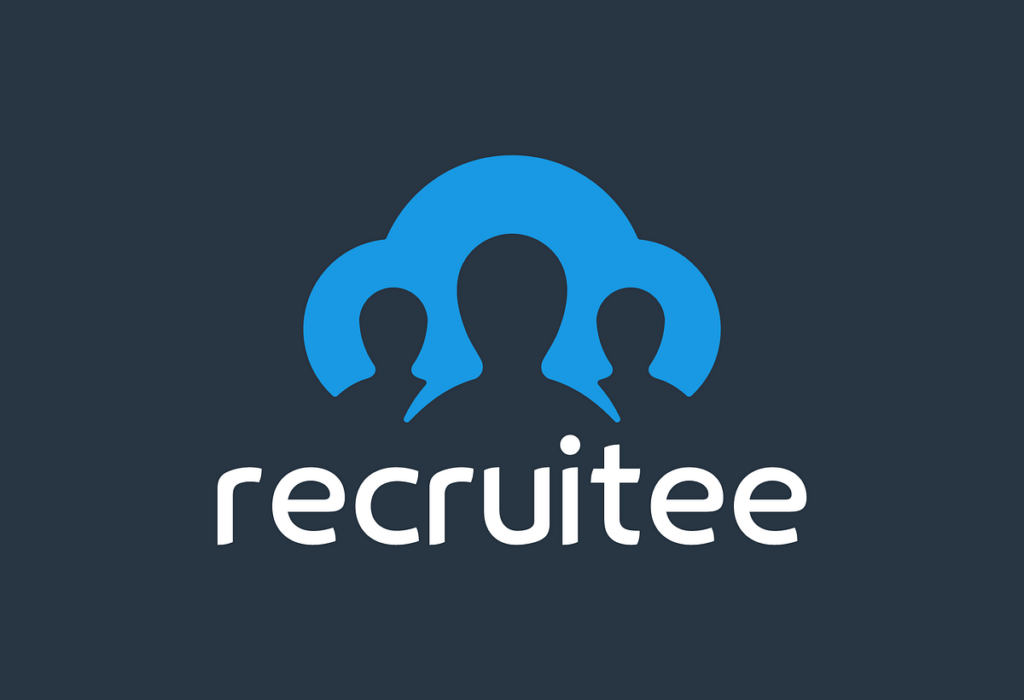
Recruitee
- Spot Score 9.3
- Best For: Collaborative hiring teams and growing businesses
- Pricing: Starts from 270/month
Recruitee is a collaborative hiring platform designed to streamline the recruitment process. It offers customizable pipelines, automation features, and a user-friendly interface, making it suitable for teams aiming to enhance their hiring efficiency.
Features
| Feature | What It Helps With |
|---|---|
| Customizable Pipelines | Allows teams to tailor hiring stages to fit their unique processes. |
| Automation Tools | Automates repetitive tasks like email follow-ups and status updates. |
| CareersHub | Enables the creation of branded career sites without coding knowledge. |
| ReferralsHub | Facilitates employee referrals to tap into existing networks for talent sourcing. |
| GDPR Compliance Features | Provides tools to manage candidate data in accordance with GDPR regulations. |
Why It Works for Growing Teams
Recruitee offers a balance between functionality and ease of use, making it ideal for teams looking to scale their hiring processes. Its collaborative features ensure that all stakeholders are involved, and its automation capabilities free up time for strategic decision-making.
Recruitee Pricing
Recruitee offers three main pricing plans:
- Start Plan: Ideal for businesses beginning their hiring journey.
- Starts at $216/month (billed annually) for 5 job slots.
- Grow Plan: Suited for fast-growing companies.
- Includes unlimited job slots and additional features like multi-language support and custom reporting.
- Optimize Plan: Designed for organizations focusing on hiring efficiency.
- Offers advanced features like BI connections, requisition approvals, and dedicated support.
An 18-day free trial is available, allowing teams to explore the platform before committing.
Pros & Cons
| Pros | Cons |
|---|---|
|
|
Side-by-Side Comparison Table
| Tool | Pricing (starts at) | Code Test Integration | AI Resume Matching | Tech Sourcing Tools | Free Trial |
|---|---|---|---|---|---|
| Ashby | $300/month | ✅ | ✅ | 🔄 (via integrations) | ❌ |
| Workable | $149/month | ✅ | ✅ | ✅ | ✅ |
| Greenhouse | Custom | ✅ | ✅ | ✅ | ❌ |
| Recruitee | $216/month | 🔄 (via integrations) | ❌ | ✅ | ✅ |
How to Choose the Right ATS for Developer Hiring
Selecting the right ATS for hiring developers isn’t just about checking off a feature list—it’s about finding the right balance between functionality, team needs, and long-term flexibility. Here are four key factors to consider during your decision-making process:
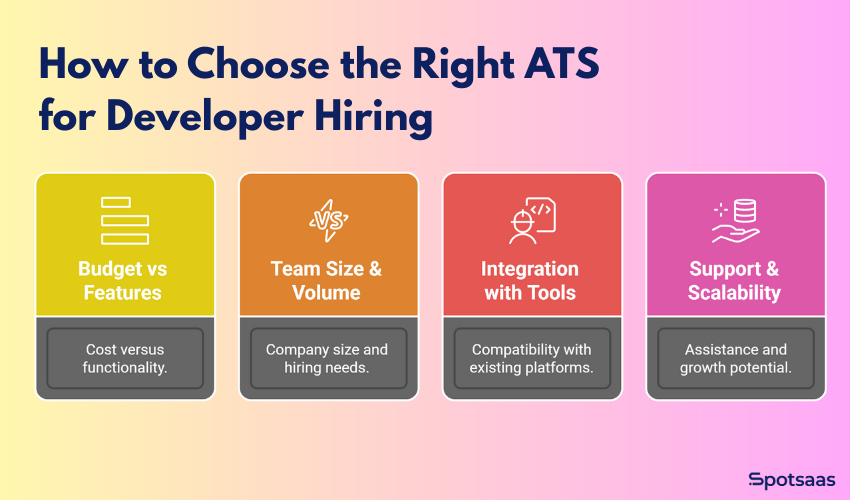
1. Budget vs Features
Start by defining what your team truly needs. Are you looking for built-in code assessments, customizable workflows, or advanced analytics? Some tools offer all-in-one solutions but come at a premium. Others may offer core features with room to scale later. Align your selection with both your current hiring goals and future growth.
2. Team Size and Hiring Volume
The needs of a small startup hiring one developer per quarter are very different from those of a mid-sized company building an entire engineering team. Look for an ATS that fits your current hiring pace while remaining flexible enough to grow with you.
3. Integration with Developer Tools
For technical hiring, integrations matter. Make sure the ATS can connect with platforms your team already uses—whether that’s GitHub for sourcing, Slack for updates, or Zapier for automating workflows. These integrations save time and keep your team in sync.
4. Support and Scalability
Reliable support and product stability can’t be overlooked. Look for a provider with responsive support, clear onboarding, and a product roadmap that matches your scale. Whether it’s data migration or training, having a responsive partner can make all the difference as your team expands.
Tips for Smooth Implementation
Adopting a new ATS is a big move, especially when hiring developers is involved. The goal isn’t just to “get it set up,” but to ensure the platform actually makes your hiring process faster, smarter, and more aligned with your team’s needs. These tips will help you roll out the system with confidence and clarity.
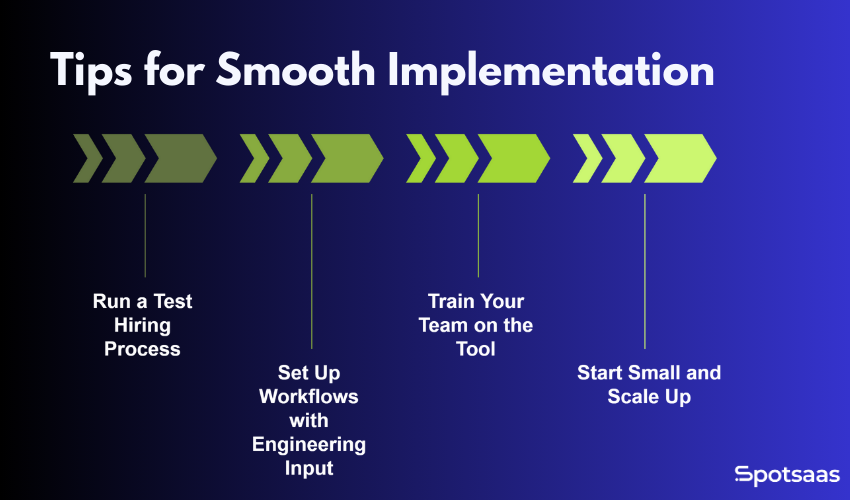
Run a Test Hiring Process
Think of this as your trial run. Choose a real or mock developer role and go through each step, from job posting to final feedback. It’s a small investment of time that can prevent larger hiccups later.
This helps identify workflow gaps, check integration accuracy (like resume parsing or interview scheduling), and evaluate how smooth the candidate and hiring team experience really is.
Set Up Workflows with Engineering Input
Your hiring pipeline should reflect how your engineering team thinks. Bring in your tech leads when defining pipeline stages, interview templates, evaluation rubrics, and test formats.
Their insight ensures your ATS mirrors the way you actually assess candidates—whether it’s code review, pair programming, or system design discussions.
Train Your Team on the Tool
Even the best software can underperform if people don’t know how to use it. Set aside time for a brief walkthrough of the ATS with key stakeholders. Focus on how to:
- Advance candidates through the pipeline
- Leave structured feedback
- View analytics or reports
- Automate follow-ups and reminders
Providing internal resources—like a quick-start guide or a Loom video—can go a long way in keeping everyone aligned.
Start Small and Scale Up
Instead of introducing the ATS across every department, begin with one or two tech-focused roles. Let the team get comfortable with tasks like scheduling interviews, reviewing applications, and collaborating on notes.
This phased approach builds confidence, gives you useful feedback, and allows for tweaks before a wider rollout.
Conclusion
Hiring developers isn’t just about finding talent—it’s about building the right process to identify, engage, and onboard the right people efficiently. An ATS built for technical hiring helps your team move faster, stay aligned, and maintain a great candidate experience at every step.
Whether you’re looking to streamline sourcing, improve evaluation accuracy, or create consistency across your hiring process, the tools we’ve covered are designed to support your goals. Take the time to match your team’s needs with the right features, run a test cycle, and build workflows with input from your engineering team.
Looking to compare these ATS platforms side by side?
Browse our detailed software listings to see real user reviews, pricing breakdowns, and key features.
Explore Top-Rated ATS Tools on SpotSaaS
Not sure which one suits your workflow?
Schedule a free consultation with our software advisors and get personalized recommendations for your agency.
Frequently Asked Questions
Do these ATS tools support coding assessments?
Yes, most of them integrate with platforms like HackerRank, Codility, or built-in coding tests.
Can I use one ATS to hire for multiple developer roles at once?
Absolutely—modern ATS platforms support multi-role and multi-department pipelines.
Are these ATS tools suitable for small teams or startups?
Yes, tools like Workable, Recruitee, and Recruit CRM offer scalable plans for smaller teams.
Do these platforms integrate with GitHub, Slack, or Zapier?
Most tools support popular integrations to streamline developer sourcing and team collaboration.
Is it easy to migrate from spreadsheets or older systems?
Yes, many ATS platforms offer import tools and onboarding support to simplify the switch.


